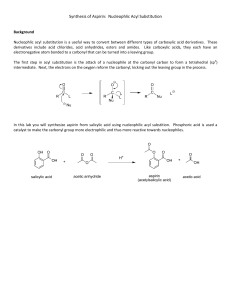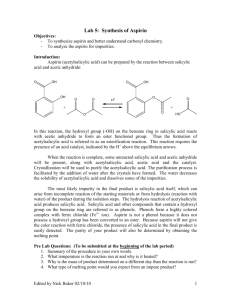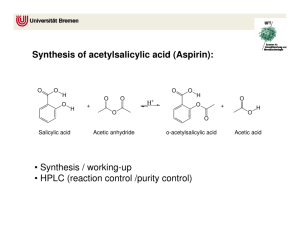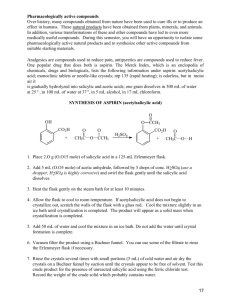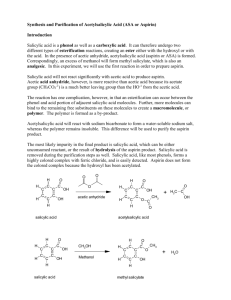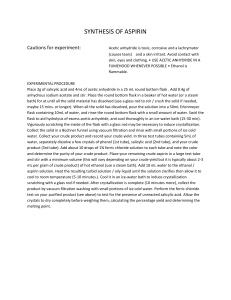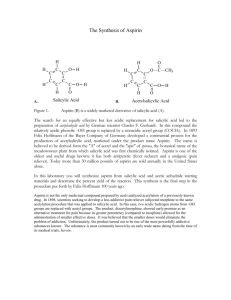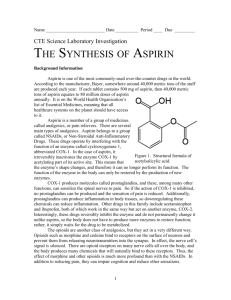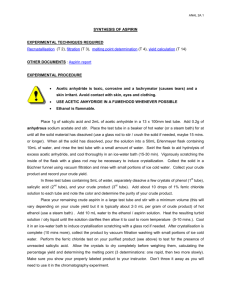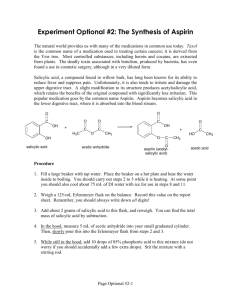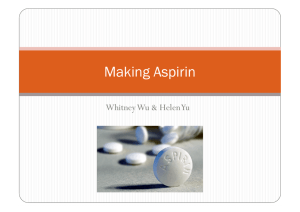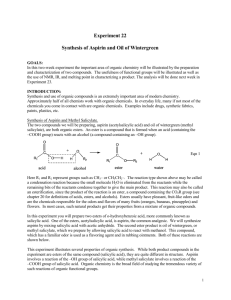The Synthesis of Aspirin - mvhs
advertisement
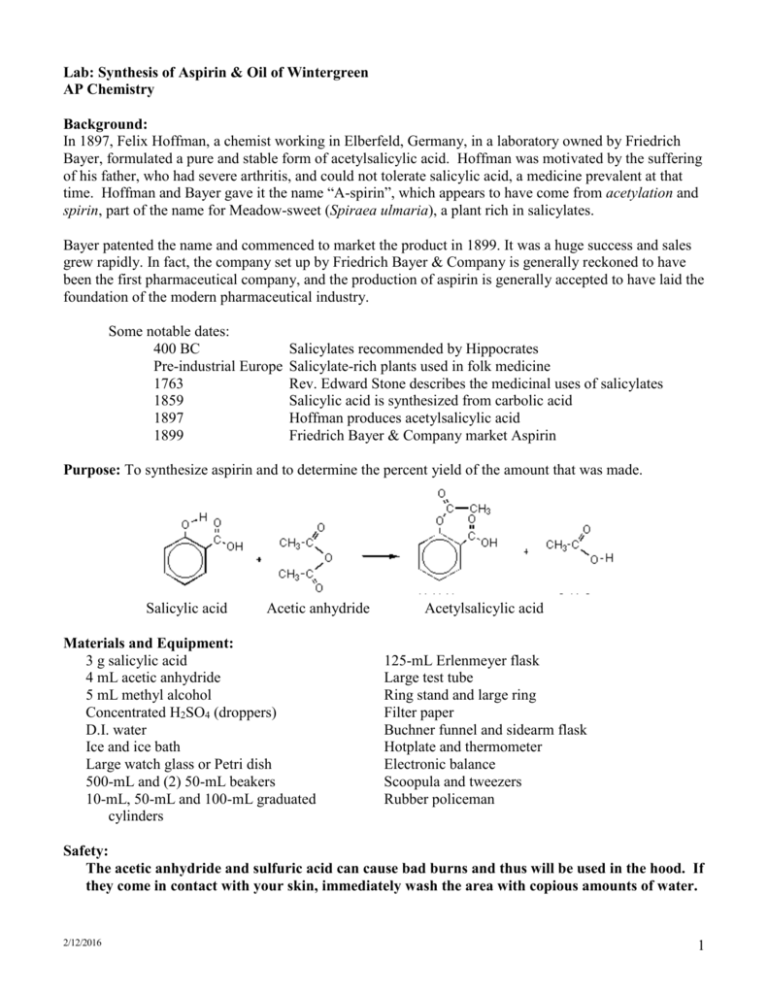
Lab: Synthesis of Aspirin & Oil of Wintergreen AP Chemistry Background: In 1897, Felix Hoffman, a chemist working in Elberfeld, Germany, in a laboratory owned by Friedrich Bayer, formulated a pure and stable form of acetylsalicylic acid. Hoffman was motivated by the suffering of his father, who had severe arthritis, and could not tolerate salicylic acid, a medicine prevalent at that time. Hoffman and Bayer gave it the name “A-spirin”, which appears to have come from acetylation and spirin, part of the name for Meadow-sweet (Spiraea ulmaria), a plant rich in salicylates. Bayer patented the name and commenced to market the product in 1899. It was a huge success and sales grew rapidly. In fact, the company set up by Friedrich Bayer & Company is generally reckoned to have been the first pharmaceutical company, and the production of aspirin is generally accepted to have laid the foundation of the modern pharmaceutical industry. Some notable dates: 400 BC Pre-industrial Europe 1763 1859 1897 1899 Salicylates recommended by Hippocrates Salicylate-rich plants used in folk medicine Rev. Edward Stone describes the medicinal uses of salicylates Salicylic acid is synthesized from carbolic acid Hoffman produces acetylsalicylic acid Friedrich Bayer & Company market Aspirin Purpose: To synthesize aspirin and to determine the percent yield of the amount that was made. Salicylic acid Acetic anhydride Materials and Equipment: 3 g salicylic acid 4 mL acetic anhydride 5 mL methyl alcohol Concentrated H2SO4 (droppers) D.I. water Ice and ice bath Large watch glass or Petri dish 500-mL and (2) 50-mL beakers 10-mL, 50-mL and 100-mL graduated cylinders Acetylsalicylic acid 125-mL Erlenmeyer flask Large test tube Ring stand and large ring Filter paper Buchner funnel and sidearm flask Hotplate and thermometer Electronic balance Scoopula and tweezers Rubber policeman Safety: The acetic anhydride and sulfuric acid can cause bad burns and thus will be used in the hood. If they come in contact with your skin, immediately wash the area with copious amounts of water. 2/12/2016 1 Procedure: A. Synthesis of Acetylsalicylic Acid 1. Day 1: Add about 200 mL of tap water to a 500 mL beaker and heat it to 80–90 C. (Continue the procedure below while you are waiting.) 2. Place about 2.0 g of salicylic acid in a 125 mL Erlenmeyer flask. Record the exact mass. 3. Once your water has reached the appropriate temperature range, take your salicylic acid flask to the hood and: a. Cautiously add 4.0 ml of acetic anhydride to your flask. b. Carefully add 4 drops of concentrated sulfuric acid to the flask and swirl to mix everything thoroughly. c. Place the flask in the beaker of warm water and heat the mixture for about 20 minutes. 4. Remove the flask from the warm water and allow it to cool to room temperature. 5. Cautiously add 30 mL of D.I. water to the mixture in the flask and thoroughly mix the contents by swirling. Use the rubber policeman to transfer the mixture to a clean 50-mL beaker. 6. Cool the mixture in an ice bath to complete the initial crystallization. 7. Record the mass of a piece of filter paper, set it up, then transfer the products for filtering. Wash the crystals with 2-3 mL of chilled water. Place the filter paper and product on a watch glass to dry overnight. 8. Clean up all equipment; all chemicals can be rinsed down the drain. 9. Day 2: Record the final mass of the filter paper and product, then put them in the trash. B. Synthesis of Methyl Salicylate 1. Day 1: Place 1 g of salicylic acid and 5 mL of methyl alcohol in a large test tube. 2. Add 3 drops of concentrated sulfuric acid and then place the test tube in a water bath at about 70C for about 15 minutes. Note the odor. Data and Observations: In the space below, create a data table to record the necessary quantitative information for this lab, as well as your observations of what occurred. 2/12/2016 2 Analysis & Discussion Questions: 1. Calculate the theoretical yield of aspirin. 2. Calculate the percent yield of aspirin. 3. Two esters with the empirical formula C3H6O2 may be prepared. Draw Lewis structures for these esters and name them. 4. Why does/might our room smell like vinegar during this experiment? 5. Draw the structure of methyl salicylate, which has a systematic name of 2-hydroxy-methylbenzoate. 6. Structurally, why are salicylic acid and acetylsalicylic acid considered acids? References: 2/12/2016 http://www.reachoutmichigan.org/funexperiments/quick/csustan/aspirin.htm http://www.aspirin-foundation.com/cardio2.htm 3
